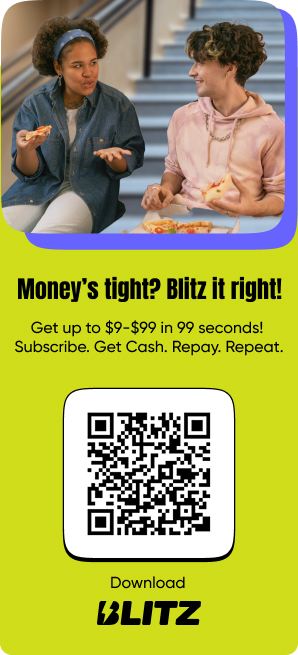When your tuition deadline is near or your rent check bounces, what’s your backup plan? That’s where an emergency student lines of credit steps in. It’s a safety net designed for students, a “just-in-case” fund you can use.
More students are opting for these lines of credit since they find that traditional loans, scholarships, and part-time jobs are not enough to cover their expenses. However, even though they sound quite convenient, they also come with a risk if you don’t use them carefully.
Blitz makes managing this smarter. With tools like BudgetGPT, Alerts, and Weekly Money Review, you can borrow when needed, track spending easily, and avoid falling into debt traps. Ready to learn how to handle them the smart way? Keep reading.
How Emergency Student Lines of Credit Work
Money tools can feel complicated, but student lines of credit are actually simple once you break them down. Let’s look at how they work and why more students are turning to them.
Defining a Student Line of Credit
A student line of credit is like a credit card, but with more flexibility and lower costs. You are approved for a certain limit, and you borrow only what you need.
With a loan, you get one lump sum and pay interest on the whole thing from day one. But with a line of credit, you pay interest only on what you actually use. That “pay for what you borrow” setup feels lighter and more student-friendly. Read to find out if $20K in Student Loans is a Lot?
Accessibility and Eligibility
Not everyone can just walk into a bank and get one of these. Lenders want proof that you won’t default.
To qualify, you usually need:
- Enrollment status: You usually need proof that you’re a student.
- Credit score: Low or no credit? You might still qualify with a co-signer (often a parent).
- Income history: Some banks ask about side jobs or scholarships that help you repay.
If you’re worried about being denied, Blitz can show you where your credit behaviors stand now and what to improve before applying.
How Students Use These Lines of Credit
Every student’s “emergency” looks different. Some students use it for tuition or textbooks. Others use it for living costs like rent, utilities, and groceries when money falls short mid-month.
Common uses include:
- Covering sudden tuition hikes or lab fees.
- Buying required textbooks, laptops, or software.
- Paying off rent or deposits on apartments.
- Handling medical bills or surprise travel costs.
But here’s the trap: what starts as a one-time fix can quickly become a regular dependency. That’s why connecting it with Blitz is crucial. Each swipe or transfer is tracked, so you never forget how much you actually owe.
The Pros of Emergency Student Lines of Credit
When used the right way, emergency student lines of credit can seriously save your semester. They’re built for flexibility and quick access, and they don’t hit your wallet like credit cards do. Here’s why many students find them helpful.
Flexibility and Immediate Access
You’re not stuck with a huge lump sum. A student line of credit lets you pull only what you need, when you need it. Emergency rent, surprise class fees, medical bills—it’s money on demand. Quick access, no questions, and totally stress-saving when life hits hard.
Lower Interest Rates Compared to Credit Cards
Credit cards are quick, but they’re expensive. Average credit card APRs can hit 20–25%. A student line of credit typically has much lower rates, making it the smarter “last resort.”
Why this matters:
- Borrowing $1000 via credit card could cost you hundreds more over a year.
- Borrowing the same amount via a line of credit saves you big with lower interest.
It’s still debt, but it’s debt on better terms. When an emergency pops up, borrowing here costs less and gives you breathing room to repay. Learn about Emergency Money for College Students.
Improved Credit Management
Using a line of credit responsibly builds your credit score. Each repayment boosts your history. This comes into play when you graduate and need to get an apartment, purchase a car, or qualify for big loans.
Tips to grow credit with it:
- Don’t max out the limit.
- Always pay at least the minimum, preferably more.
- Track credit score growth with Blitz’s credit monitoring features.
Think of it less as free money and more as an investment in your “future borrowing power.”
The Cons of Emergency Student Lines of Credit
Of course, every upside has a flip side. Here’s where things can go wrong if you’re not careful.
Risk of Overspending
Having a credit line feels good until you start using it like a second wallet. They might think, “I’ve got backup money.” Small expenses add up, and before you know it, you’ve borrowed more than you can handle. That’s why you should only use it for true emergencies. Blitz can help you set spending limits.
Variable Interest Rates
Not all credit lines have fixed rates. Some go up and down with the market, which means what looks cheap today might not be next semester.
- A 5% starting APR can rise to 9% or higher.
- Long-term borrowers may pay way more in interest than planned.
- It’s unpredictable and stressful if you’re on a tight budget.
If you’re already juggling tuition and living costs, large swings in repayment can hurt.
Potential for Accruing Unmanageable Debt
If you keep borrowing without paying it down, debt can snowball fast. That once-harmless balance becomes a monthly weight you carry. It messes with your plans. Use Blitz’s tools to track balances, build repayment habits, and stop debt before it gets out of control.
Traps to Watch Out For with Emergency Student Lines of Credit
Lines of credit can feel like the perfect solution when money gets tight, but there are strings attached. If you don’t pay attention, small mistakes can lead to big financial stress. Here are the major traps to keep your eye on.
Hidden fees and charges
It’s not just the interest you’re paying; banks often sprinkle in fees that quietly drive up the cost.
Possible fees include:
- Processing or setup fees just to open the line.
- Annual maintenance fees.
- Late payment penalties.
- Transaction fees every time you tap into your credit.
Before signing, read the terms carefully. And let Blitz’s Alerts track upcoming fee deadlines so you never pay late or get hit with surprise costs.
Consequences of Defaulting
Missing payments or, worse, defaulting on your student line of credit can drag you down fast. Here are some consequences you might face:
- Your credit score can drop fast.
- You could lose access to future loans, apartments, or even job opportunities.
- Your co-signer (probably your parent) could get stuck with the bill. Awkward.
- The bank might freeze your account.
Instead of waiting for overdue notices, Blitz keeps repayment reminders front and center. You don’t just remember deadlines, you get a reminder before you’re ever late.
The Debt Spiral Trap
The scariest risk is falling into what’s called the debt spiral, using credit again and again until you’re buried.
It happens because:
- Students underestimate how small debts accumulate.
- Emergencies keep popping up (they always do).
- Interest keeps building on old unpaid balances.
But building a budget plan with BudgetGPT avoids this spiral. Every emergency is weighed against long-term financial capacity, so debt doesn’t become the default solution.
How to Use Emergency Student Lines of Credit Wisely
Emergency student lines of credit don’t have to be dangerous. In fact, they can be smart when you understand how to use them. Here’s how to make sure it helps instead of hurts:
Setting Clear Financial Goals
Before borrowing, pause. Ask yourself: What’s the actual purpose?
Steps to stay goal-oriented:
- Define “real emergencies” vs. wants.
- Consider cheaper alternatives like (campus aid, scholarships, Blitz Quick Cash).
- Skip it for non-essentials like clothes, takeout, or late-night impulse buys.
With Blitz’s BudgetGPT, you can set monthly goals, compare financial options, and make a smart call before you ever draw a cent. Having a plan turns your line of credit into a backup, not a habit.
Staying Within Your Credit Limit
A high credit limit might look tempting, but it doesn’t mean you should borrow the full limit. Instead, use only what you truly need, not what’s “available.”
Here are some smart ways to manage:
- Stick to a monthly cap based on real needs.
- Track your usage and repayment schedule every week.
- Avoid “just this once” overspending—it adds up.
Blitz’s budgeting tools help you set alerts and auto-track your spending, so you always know where you stand.
Paying Off the Balance Quickly
The longer you wait, the more you’ll pay. Paying just the minimum may be easier, but it keeps you in debt for years.
Tactics to try:
- Try to pay more than the minimum every month.
- Use part of the side hustle income directly toward the balance.
- Schedule automatic payments after payday to stay ahead.
If you’re in a pinch, Blitz’s Instant Cash feature can give you a short-term cushion without using your emergency line or credit fund.
FAQs on Emergency Student Lines of Credit
How can I qualify for a student line of credit?
Not too difficult, you generally have to be enrolled, provide income documentation or a co-signer, and possess a good credit history (or a co-signer with a good one).
What’s the difference between a student line of credit and a student loan?
With a student loan, you receive all the funds at once and immediately begin paying interest. Whereas in a line of credit, you are allowed to take only as much as you require and pay interest only on that portion.
Can I use an emergency student line of credit for everyday expenses?
For sure, it can also be used to pay for your groceries, rent, or coffee breaks. But it’s really designed for emergencies. Using it daily just piles up debt faster than you’ll want to repay later.
How do interest rates on student lines of credit compare to credit cards?
Way better! Lines of credit rates are much lower, making them a smarter fallback in emergencies. Credit cards can hit 20%+ APR, which can wreck your wallet if balances grow.
What happens if I default on my student line of credit?
Your credit score suffers fast, limits future borrowing, and adds stress with bank penalties. That’s where Blitz Alerts save you, reminding you before things ever spiral out of control.
Is an Emergency Student Line of Credit Right for You?
Emergency student lines of credit can save lives, though only when they are used properly. They have easy access, are flexible, and are less expensive than credit cards, but there are hidden traps if you do not pay attention to them. The safety net will very soon become a trap of debt.
But Blitz keeps emergency credit easy, secure, and student-friendly to manage. With BudgetGPT and other tools, you can place safe limits, monitor your borrowing, and have bad habits identified early.
Try Blitz today and turn emergency borrowing into smart money moves.





